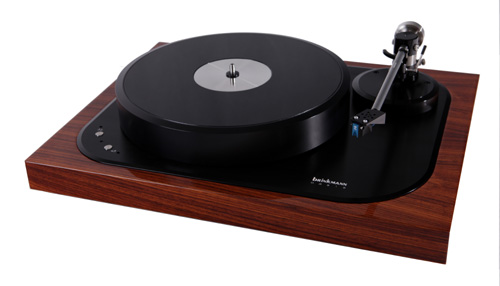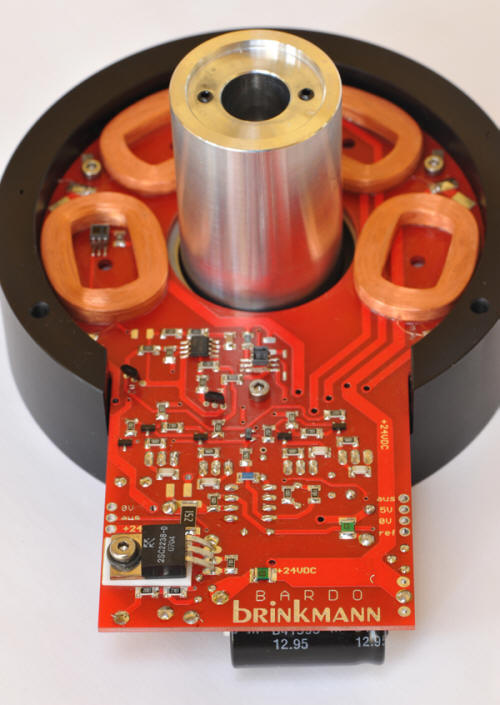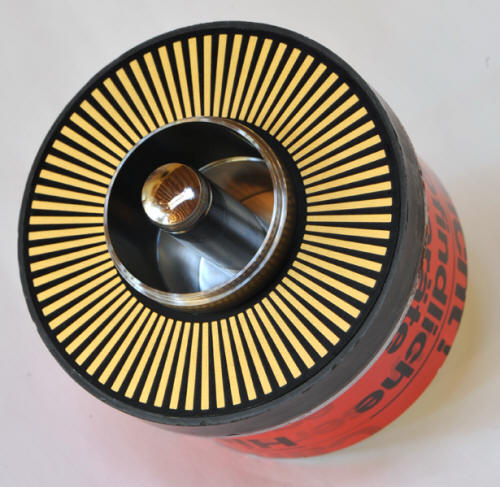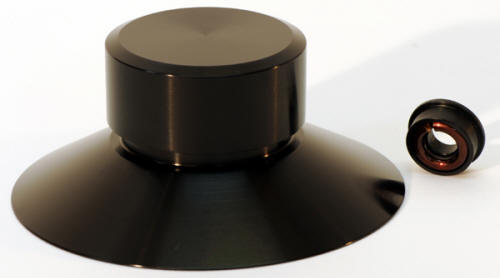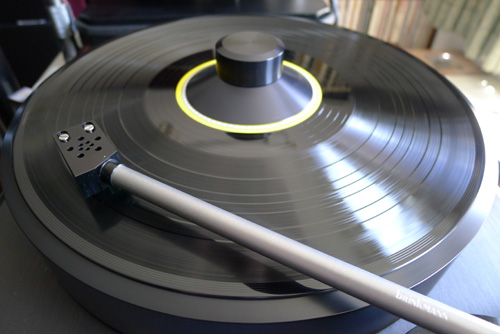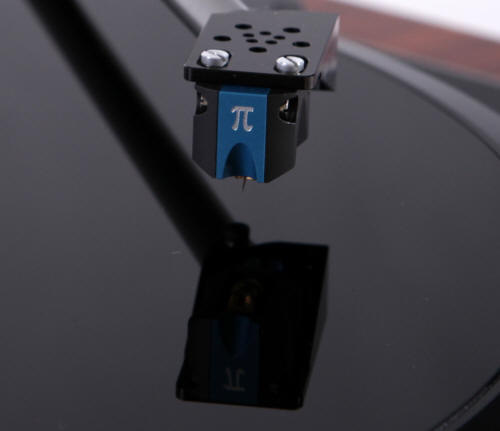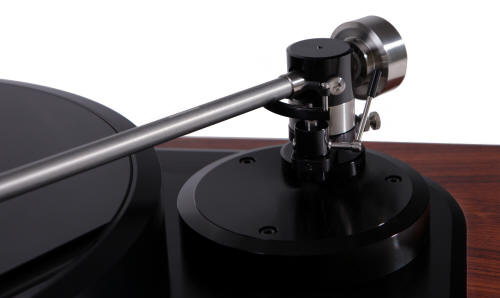|
|
You are reading the older HTML site
Positive Feedback ISSUE 68
brinkmann Oasis Turntable, 10.0 Tonearm, and Pi Cartridge as reviewed by Marshall Nack
Hold and Release Perhaps the thing to comment on first regarding the Brinkmann analog package is how it lets go of notes. It brought to mind a modern dance by Garth Fagan entitled Prelude: Discipline is Freedom. The piece begins with the dancers doing basic warm-up movements, then steadily gains momentum and complexity, until a lively series of jumps and turns along the diagonals of the stage has the audience on the edge of their seats—or dancing in them—at the finale. It only works when the dancers have mastered their parts sufficiently to appear relaxed. Then, the dance itself appears effortless. Now, what on earth does this have to do with how the Brinkmann Oasis Turntable lets go of notes? Many tables and arms—actually, many components in general—utilize damping to control the signal and achieve higher resolution. But, where a little is good, there's always the temptation to eke out more. If overdone, you're guaranteed to tamper with stuff that should be left alone and reveal your hand to the listener in the form of tight and squashed sound. (Of course, you can also err on the other side and under-damp, in which case the sound has no form and is left flapping in the wind.) The Brinkmann front-end strikes an excellent balance. It masters its parts through the application of control, as evidenced in superior detail retrieval. Yet the decay dissipates naturally; it lets go of notes with no sense of being over-damped. I won't go into much depth now, except to say this balancing act is evident everywhere. The transient, for example, is as close to a square wave as I've heard, yet avoids feeling over-controlled. The Engineering Counterpart You don't have to look far to find an example of the engineering counterpart. Look at the construction of the platter. It is made from a special resonance-inhibiting alloy of aluminum, copper, magnesium and other materials. But the top surface that comes in contact with the record is a crystal glass inset. Not only is glass an extremely smooth and even material, it is sonically lively as well. Nice balance.
Proportional Regulation of the Motor Perhaps the most significant example of the balancing act between freedom and control is how Brinkmann implemented direct drive in the Oasis. From the website: "Many of the known direct drive turntables were constructed for studios and radio stations where it was necessary to have very quick start-up times of less than a second which was achieved with high torque motors that speed up and stop the motor very rapidly. This caused heavy cogging effects accompanied by high wow & flutter numbers." (Cogging: "very short phases of acceleration alternating with equally short phases of braking… Cogging is intrinsic to all electric motors.") Thus, direct drive acquired a bad rep. Brinkmann envisioned a new paradigm for the motor/platter interface. They rejected tight regulation of the platter and developed a motor control with low torque—just enough to get the platter up to speed and keep it constant. Plus they paired the low-torque motor with a high mass platter. Consequently, it takes the platter a long time to ramp up to 33⅓ rpm (about 16 seconds), but cogging is greatly reduced. Also, once the 22lb. platter is moving, it tends to keep moving due to the laws of inertia, especially since the motor off phase is a minimal countervailing force. Both of these innovations help to smooth out the drives' miniscule speed variations.
Speed controller with four inductors Magnetic Motor Drive Wow and flutter are further reduced through magnetic coupling. The drive mechanism consists of four air-cored inductors in the plinth and a ring of permanent magnets in the platter's bearing. A Brinkmann-developed analog speed control charges the inductors with just enough juice to maintain speed accuracy. The inductors transfer their electric charge to the ring of magnets in the platter which, in turn, transfer it to the motor.
Ring magnets in sub-platter The spindle is built into the motor housing and protrudes through the platter. When you screw the record clamp into the spindle, you are locking the record and platter to the motor housing. Voilà! The clamp design also has the effect of flattening the record to the glass mat. These engineering choices result in a table with excellent pitch stability and ultra-low noise—and a sound that's quite different from my reference.
Listening Observations: Dr. Feickert Firebird I've gotten quite used to the way my reference Dr. Feickert Firebird table, DFA-12.0 arm and Shelter Harmony cartridge does it. (Note that while the parts vary widely, the total price of these packages are quite close. The Oasis list is $13,400; the Firebird is $13,000. The 10.0 arm is $4000; the DFA, $1500. The Pi cartridge is $2700; the Harmony, $5500.) Here, there's no real end to the musical line. One note trails off and, before it's gone, another begins. The musical line just keeps moving along, resulting in continuity. The transient is softer, the sustain is full of life, and the tail takes its time to dissipate. These are characteristics of belt drive turntables in general.
Dr. Feickert Firebird The Shelter Harmony's bloom and comparatively rich tone are also partly responsible for this attribute. One of the deciding factors in my purchase of the cartridge was that it is both highly musical and hi-res. Oasis with 10.0 Arm and Pi Cartridge The direct drive Oasis with Brinkmann 10.0 arm and Pi Cartridge (a complete Brinkmann front end installed by the distributor, On A Higher Note) dispenses with a lot of the bloom and warmth. Frequency response is dead-on neutral and, boy, is it quiet!
But the main difference between the two analog packages has to do with the duration of notes over time. With the Brinkmann, there's more space between the notes—lots more. A note begins and then ends. The next begins, then ends. The transient is like a razor edge, and the tail dissipates equally fast. In other words, there's no smudge or blur: notes are cleanly demarcated, and the table doesn't hold onto them. The view into the Brinkmann soundstage is always in sharp focus, a continual progression of differences large and small. Inner life is comprised of details. The Brinkmann is resolute in the sense that its main characteristic is resolution. The Feickert front-end's main characteristic is a flowing, wavy line comprised mainly of tonal and timbral modulations. If you're wondering what's responsible for this start and stop action and incisive resolution, all of the pieces—table, arm, cartridge—contribute, but I suspect it's overwhelmingly the direct drive design, which has astoundingly low wow and flutter measurements. (Check the website for the numbers.) You might think this is the description of an analytic table. Ah, but here's the kicker: The Brinkmann is, in its own way, just as musical and satisfying as the Feickert/Harmony combo. For one, because it is extremely quick and nimble, transients turn sharp corners and really nail the rhythms. And timbres, if not as developed as the Feickert/Shelter, are accurate. They are credible and I have no issues here. Now we come back to that wonderful balance I described at the beginning. While it exerts rigorous control over the signal, it is never overdone. The listeners' impression is always of a natural flow of notes and, in fact, the Brinkmann has a lively quality—it can dance. It is that rare component that does both. I was thinking it could use a little more punch on the bottom until I put on the Infernal Dance from Stravinsky's Firebird Suite (Sheffield Lab, LAB 24), a direct-to-disc recording from 1985. Ouch! Those whacks on the bass drum really hammer you. That they're tight and pitch-perfect is icing on the cake. The Brinkmann package is capable of delivering the thunderous crescendos on the record: just don't expect it to add it when it's not. The Berceuse (track 6) is Exhibit A for how to do string tone right. Again, inner life in the Brinkmann means focus and resolution—vibrato and dynamic fluctuations come right through. Tone is spot on. It just seems closely miked. Cosmetics The Oasis is an elegant object, no doubt about that—a modern classic. It has similar lines and proportions to many other tables, except they are more aesthetically pleasing. Everything about it exudes high quality German engineering—the finely crafted metal work, the assured action of the controls, the luxe wood plinth—and conspires to instill consumer confidence. (Other finishes available are maple, cherry, pallisander and piano gloss.) My sample was Makassar ebony wood and it was stunningly gorgeous. Setup The Brinkmann Oasis Turntable, 10.0 Tonearm and Pi Cartridge were setup on my active Vibraplane ELpF platform. (The Firebird package resides on my other ELpF.) We removed the RCA terminal box on the rear to insert a right-angled Kubala-Sosna Emotion DIN phono cable (MSRP $3000) directly into the tonearm base, thus eliminating an unnecessary cable interface. A K-S Elation! power cord went into the outboard power supply. Once setup, the Oasis was totally maintenance free. Speed was stable as a rock. The reference system for this review included the Allnic H-3000V and the superb Vitus SP-102 phono stages (review coming). Some tables (and phono stages) have the ability to suppress unwanted tics and pops. This is not one of them. Along with the privilege of hearing more deeply into the grooves, I found I had to be more diligent than ever about record care. I adopted the habit of cleaning the stylus before every play. (Not a bad habit to get into, just that it takes more time.)
Brinkmann Pi Cartridge It's noteworthy that from the lead in to the runoff groove, I am able to play complete LP sides without distortion or tracking errors. The Pi is an excellent tracker, with a very neutral tonal balance reminiscent of the Benz cartridges, and somewhat lighter than my Shelter Harmony (MSRP $5500) or the Air Tight PC1s ($8500). Both of those much more expensive carts are sweeter and more full-bodied from top to bottom.
Brinkmann 10.0 Tonearm The new Brinkmann 10.0 tonearm differs from the gimbal bearing construction of the 10.5 and 12.1 tonearms. It is a hybrid with the idea being to harness the advantages of a single point bearing with those of the gimbal type and, thus, control arm movement in all directions. New feature: the headshell allows for azimuth adjustment. Conclusion The Brinkmann front-end (Oasis Turntable, 10.0 Tonearm and Pi Cartridge) is my first experience with a direct drive turntable. It is quite a bit different from the familiar belt drive ones. In an ideal world, I want something that plays the music and lets me know the record needs to be cleaned. Yes—certainly, many of us relate to that. We want to be emotionally engaged and also want all the information to be had. The Brinkmann front-end is voiced for maximum resolution. There's nothing soft or romantic about it. It maintains 20/20 focus all the time. But lest you get a lopsided impression, I hasten to add that this combo scores equally high on musical engagement. Evidence of a designer carefully balancing these twin goals is apparent in all aspects of these products. The results speak for themselves: the package as delivered scores excellent on resolution, timing and tracking accuracy, and it sounds lively and natural. I found it thoroughly engaging on both fronts and so did every member of my panel. The Brinkmann package is a truly reference level analog front-end that is competitively priced. It is special and belongs on your short list. Very well done, Herr Brinkmann! Postscript After completing this review, I replaced the Pi cartridge with an Air Tight PC1s. Ahhhh. What can I say? The PC1s matched the Pi in resolution while bringing a special kind of insight that catapulted this front-end into the highest caliber, regardless of price. Review forthcoming. Marshall Nack
Oasis Turntable
10.0 Tonearm
Pi Cartridge
Brinkmann Importer
ON A HIGHER NOTE |









